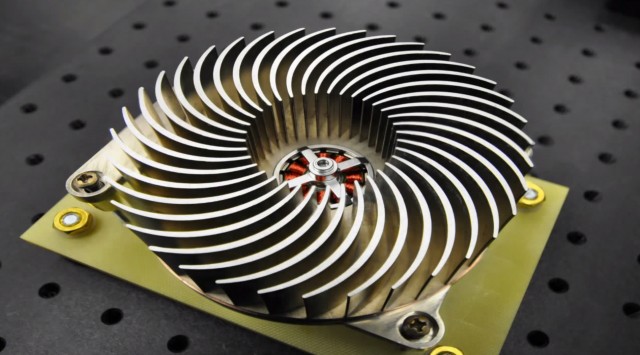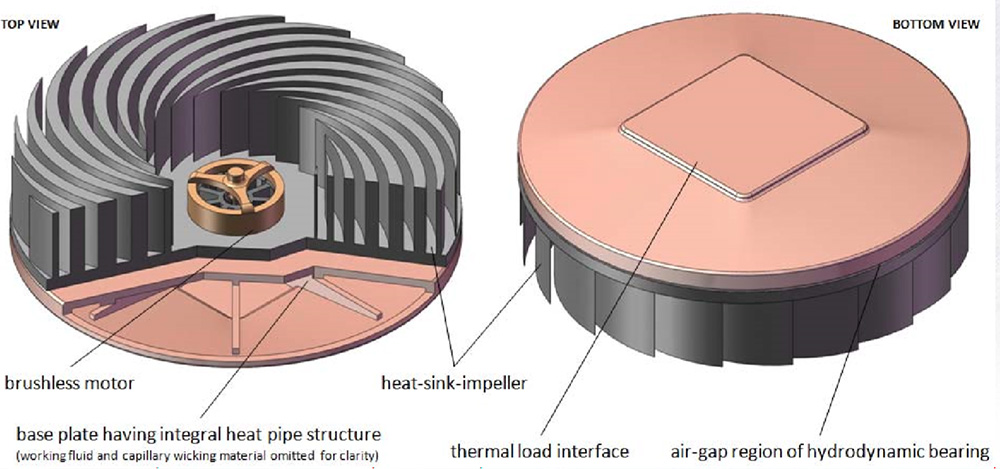|
By Sebastian Anthony on June 25, 2012 at 10:45 am The fanless, almost-silent, dust-immune, 30-times-more-efficient Sandia Cooler heatsink is almost ready for prime time. Sandia National Laboratories has announced that two companies — one computer heatsink maker, and one LED light maker — have licensed the technology. In the Sandia Cooler, the heatsink itself is the fan. It is a cast metal impeller that floats on a hydrodynamic air bearing just a thousandth of an inch (0.03 millimeters) above a metal heat pipe spreader, powered by a brushless motor in the middle. The end result is a cooler that is very quiet and 30 times more efficient than a fan-and-heatsink solutions. The prototype (shown above and in the video below) is 10 times smaller than a commercial state-of-the-art cooler, but has the same cooling performance. The Sandia Cooler’s silent operation is due to the fact that a fanless design has a lot more flexibility, whereas the fan in a standard air cooler just needs to drive as much air as possible. The Sandia Cooler’s impeller blades can have a geometry that perfectly splits the air at the impeller entrance (in the middle) and rejoins the air flow at the exit (the edges). Fast forward to 3:30 in the video if you want to hear just how quiet it is. The dust immunity derives from two facets of the Sandia Cooler’s design: a) Because they’re constantly moving at 2000+ RPM, it’s almost impossible for dust to settle on the heatsink’s blades, and b) Centrifugal force drives out any dust from the tiny air gap between the heatsink and heat spreader. This centrifugal force is what gives the Sandia Cooler such massive efficiency, too. In standard heatsinks, the heat exchange surface is covered in “dead air” boundary layer that acts as an insulator; in the Sandia Cooler, the centrifugal force reduces the thickness of this boundary layer by 10 times. Back in July 2011 we interviewed Jeff Koplow, the engineer who invented the Sandia Cooler. If you’re interested in the technical implementation of the cooler, I strongly suggest you read through his responses. (pdf) Moving forward, the Sandia Cooler’s high efficiency (and relatively small size) makes it an ideal replacement for just about every fan-and-heatsink installation in the world. Koplow has estimated that if every conventional heatsink in the US was replaced with a Sandia Cooler, the country would use 7% less electricity. For the most part, these savings would come from air conditioning and refrigeration systems — but for now, it seems like computers and LED lights will be the first devices to receive Sandia Cooling treatment. In computers, a Sandia Cooler would mean that we could finally cross the 4GHz/150W TDP thermal wall — or build computers that are thinner and quieter. For LED lights, their performance is currently limited by heat dissipation. For small, at-home fixtures, noisy active cooling solutions are obviously not viable — but a silent, highly-efficient, smaller version of the Sandia Cooler would be perfect. There’s no word on which CPU or LED maker has licensed the Sandia Cooler, but I’m sure we’ll find out soon enough — such technology is too awesome to keep locked up for long. http://www.extremetech.com/computing/131656-the-fanless-heatsink-silent-dust-immune-and-almost-ready-for-prime-time
Comments are closed.
|
Archives
March 2021
|


 RSS Feed
RSS Feed